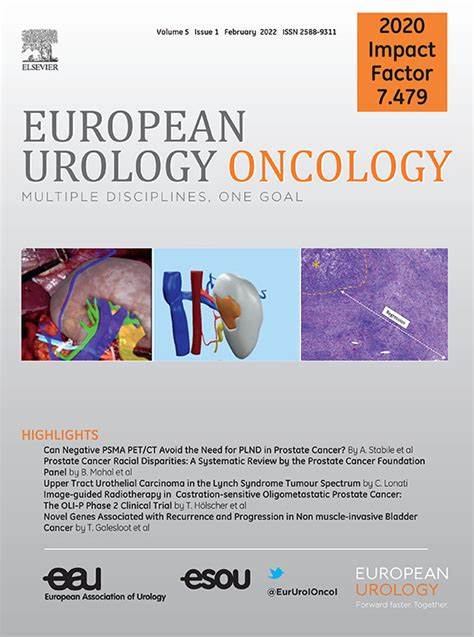基线前列腺特异性抗原低于3ng /ml的男性前列腺癌死亡的长期风险:来自芬兰前列腺癌筛查随机研究的证据
IF 9.3
1区 医学
Q1 ONCOLOGY
引用次数: 0
摘要
背景和目的:尽管有证据表明前列腺特异性抗原(PSA)筛查可以降低前列腺癌(PCa)死亡率,但PSA的最佳临界值和低初始PSA水平在预测前列腺癌长期死亡率方面的临床意义仍然是正在进行的研究的主题。在芬兰前列腺癌随机筛查研究(FinRSPC)的第一轮筛查中,我们评估了初始PSA水平低于3ng /ml的男性的PCa死亡率。方法:进行了一项回顾性队列研究,包括来自FinRSPC筛查组的20268名男性,初始PSA水平为:主要发现和局限性:在17.8年的中位随访期间,诊断出1840例PCa病例,发生128例PCa死亡,累积PCa死亡率为0.6%,死亡率为每10000人年4例。在PSA水平为2-2.99 ng/ml (HR 5.0, 95% CI 3.1-8.1)时,PCa死亡率比在PSA水平为2-2.99 ng/ml时高5倍。结论和临床意义:我们的研究结果强调了在PCa筛查中采用细致的PSA方法的重要性,表明在PSA水平较低时将PSA与其他检测相结合的效用,并表明在PSA水平较低时67-71岁停止筛查的风险最小。患者总结:在这项研究中,我们分析了初始前列腺特异性抗原(PSA)水平低的芬兰男性的前列腺癌死亡情况。我们发现前列腺癌死亡的风险与PSA相关,尤其是在年轻男性中。如果PSA仍然很低,在67-71岁时停止筛查是安全的。本文章由计算机程序翻译,如有差异,请以英文原文为准。
Long-term Risk of Prostate Cancer Mortality Among Men with Baseline Prostate-specific Antigen Below 3 ng/ml: Evidence from the Finnish Randomized Study of Screening for Prostate Cancer
Background and objective
Despite the evidence for prostate-specific antigen (PSA) screening reducing prostate cancer (PCa) mortality, the optimal PSA cutoff and the clinical significance of low initial PSA levels in predicting long-term PCa mortality remain subjects of ongoing research. We assessed PCa mortality among men with initial PSA levels below 3 ng/ml during the first screening round of the Finnish Randomized Study of Screening for Prostate Cancer (FinRSPC).
Methods
A retrospective cohort study was conducted, including 20 268 men from the screening arm of the FinRSPC with an initial PSA level of <3 ng/ml, with follow-up spanning up to 20 yr. Hazard ratios (HRs) and their 95% corresponding confidence intervals (CIs) were estimated using a Cox regression analysis.
Key findings and limitations
During a median follow-up of 17.8 yr, 1840 PCa cases were diagnosed and 128 PCa deaths occurred, with the cumulative PCa mortality of 0.6% and a mortality rate of four per 10 000 person-years. PCa mortality was five-fold higher at PSA levels of 2–2.99 ng/ml (HR 5.0, 95% CI 3.1–8.1) than at <1 ng/ml. Deaths from cases with Gleason score <7 and European Association of Urology low-risk group tumors showed a stronger association with PSA, particularly in the 2–2.99 ng/ml range versus <1 ng/ml. Additionally, PCa mortality in younger men (55–58 yr at entry) exhibited a stronger association with PSA than that in older men (67–71 yr at baseline). Addition of the cumulative number of PSA tests slightly improved the overall prediction of PCa death based on Harrell’s C-statistic (base model 0.683 vs 0.717). The relatively small number of deaths, particularly among men with low-risk disease, may potentially limit the statistical precision of the results.
Conclusions and clinical implications
Our findings highlight the importance of a nuanced approach to PSA in PCa screening, suggesting utility for combining PSA with other tests at low levels and indicating minimal risk associated with discontinuing screening at ages 67–71 yr when PSA is low.
Patient summary
In this study, we analyzed prostate cancer deaths in Finnish men with low initial prostate-specific antigen (PSA) levels. We found that the risk of prostate cancer death increases in relation to PSA, especially in younger men. Screening might safely be stopped at ages 67–71 yr if PSA remains low.
求助全文
通过发布文献求助,成功后即可免费获取论文全文。
去求助
来源期刊

European urology oncology
Multiple-
CiteScore
15.50
自引率
2.40%
发文量
128
审稿时长
20 days
期刊介绍:
Journal Name: European Urology Oncology
Affiliation: Official Journal of the European Association of Urology
Focus:
First official publication of the EAU fully devoted to the study of genitourinary malignancies
Aims to deliver high-quality research
Content:
Includes original articles, opinion piece editorials, and invited reviews
Covers clinical, basic, and translational research
Publication Frequency: Six times a year in electronic format
 求助内容:
求助内容: 应助结果提醒方式:
应助结果提醒方式:


